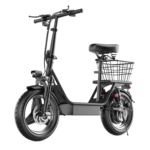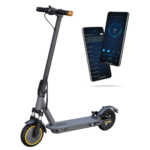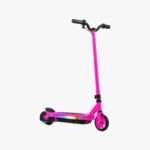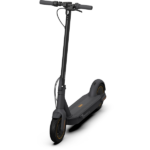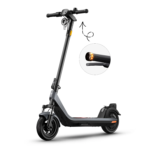- Home
- Scooters
- Electric Scooters
- Hiboy Q2
Hiboy Q2
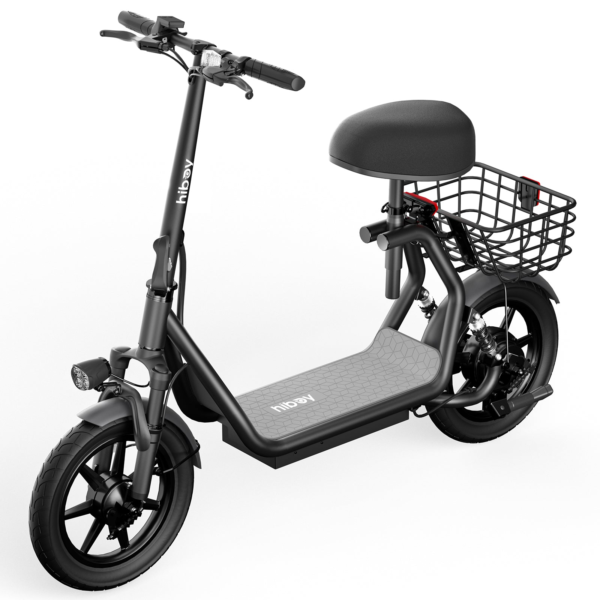

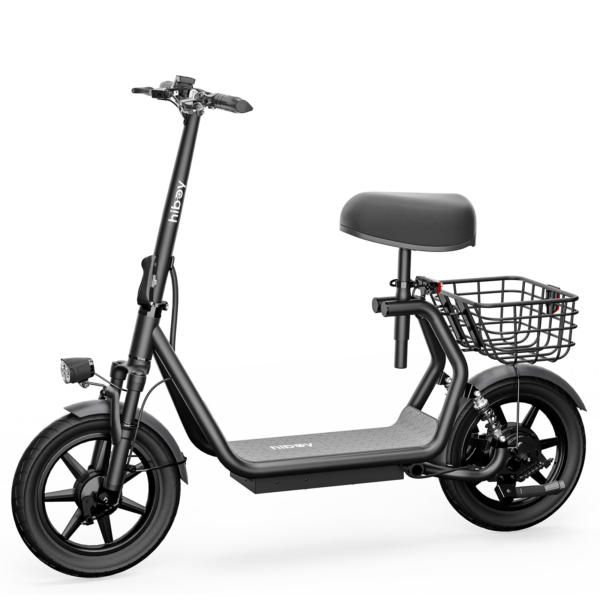
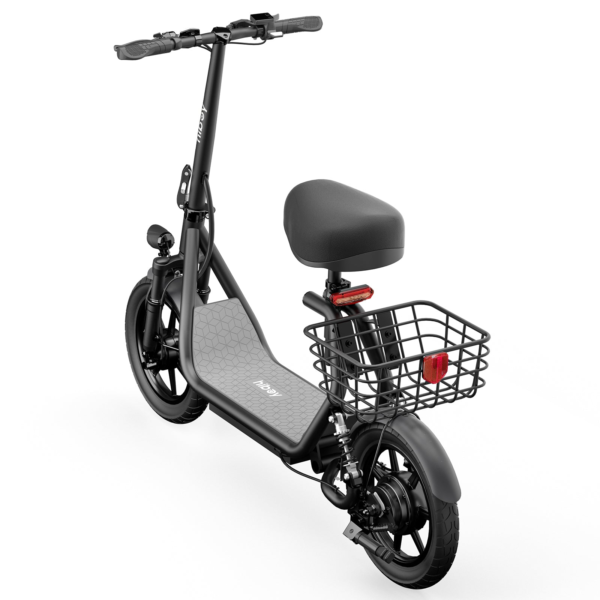
- Battery Range: 9 mi (14 km)
- Top Speed: 10 mph (16 km/h)
- Motor Power: 200 W nominal
- Weight Capacity: 132 lb (60 kg)
- Charging Time: ~4 h
- Scooter Weight: 19.8 lb (9.0 kg)
PROS
- Kid-friendly speed and controls
- Simple e-brake + foot brake
- Honeycomb tires resist flats
- Light and easy to carry
- Bright lighting and bell
CONS
- Not for adult riders
- Short range for longer outings
- Solid tires ride firm
- Limited hill ability

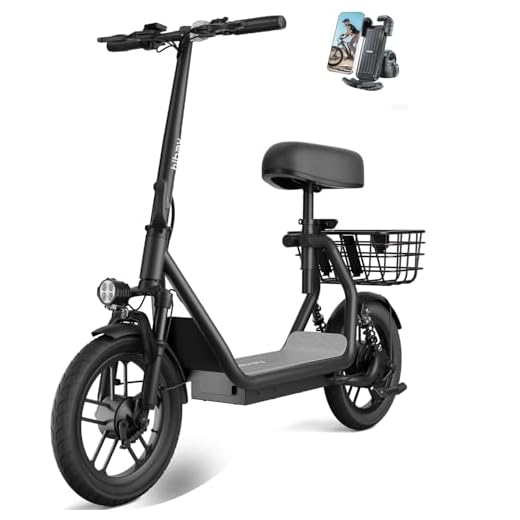
Overview: Hiboy Q2 — Kid-Friendly, Confidence-Building Rides
The Hiboy Q2 is designed for young riders who are learning balance, braking, and road awareness on shared paths. To start, it keeps speeds modest, controls simple, and maintenance low for parents. Moreover, a gentle motor tune, a clear display, and a sturdy frame make practice sessions fun and predictable. As a result, if you want a kid-ready scooter that focuses on safety and ease, the Q2 keeps weekends smooth and family rides pleasantly relaxed.
In practice, acceleration is calm, and braking is simple: an electronic assist slows smoothly while a rear foot brake provides a familiar mechanical backup. Furthermore, the deck sits low and stable, and solid tires shrug off debris that would flatten tubes. In addition, bright lighting improves visibility at dusk, and a bell helps kids signal politely on neighborhood paths. Overall, the package centers on control and confidence, not top speed or flashy numbers.
For ongoing ownership, charge after rides, store indoors, and check the latch monthly. Meanwhile, teach children to coast early into stops and to keep speeds respectful in crowds. Ultimately, read the specifications once, then match the scooter to your child’s size and local rules—the Q2 is a calm, structured way to start.
Who the Hiboy Q2 Is For
First and foremost, the Q2 is for elementary-age riders who are past the push-toy phase and ready for a small, power-assisted platform. Because its acceleration is gentle, kids can practice starts without fear of being yanked forward. Additionally, parents who prefer fewer adjustments and simpler maintenance will appreciate the solid tire design and straightforward controls.
Secondly, it suits families who ride together on quiet streets, bike paths, and park loops. Consequently, older siblings can ride bikes while younger ones roll the Q2 without struggling to keep up or falling behind.
Third, it benefits children who are building essential traffic habits—looking over the shoulder, signaling, and holding a straight line. Since the scooter’s geometry is stable, kids can focus on situational awareness rather than wrestling the handlebars.
Finally, it helps cautious riders gain confidence. Because the deck is low, mounting and dismounting feel natural; therefore, slow-speed practice sessions become calm and repeatable.
Safety First: The Core Principles
Above all, kid scooters should be predictable. Accordingly, the Q2 emphasizes:
- Low, progressive power: Thus, throttle inputs translate into modest forward motion rather than sudden lurches.
- Two-layer braking: Specifically, an electronic assist decelerates smoothly while the rear foot brake offers a familiar mechanical stop.
- Stable stance: Because the deck is low and broad, planted feet and a steady center of gravity are the norm.
- Always-on visibility: In particular, front and rear lights plus reflectors help kids be seen at dusk.
- Audible courtesy: Meanwhile, the bell gives children a polite way to alert walkers on shared paths.
Put simply, these elements help kids practice the right moves consistently, which—and this is crucial—builds the kind of muscle memory that supports safe riding later.
Fit & Sizing: Matching the Scooter to the Child
Before anything else, match the scooter to the rider’s height and skill. Generally speaking, bars should hover around mid-torso to low chest when the child stands on the deck. If the bars sit too high, steering becomes vague; if they sit too low, the rider may hunch and fatigue early.
To dial fit quickly:
- Check stance width. Ideally, the front foot points forward and the rear foot rests across the deck for balance.
- Verify reach. Naturally, elbows should be slightly bent, with wrists straight on the grips.
- Confirm visibility. Because kids are shorter, ensure lights are aimed to illuminate the path rather than the front tire.
- Assess control. During a parking-lot test, ask your child to roll, stop, and look over a shoulder while holding a straight line.
If anything feels awkward, tweak bar angle or grip position. In most cases, small changes transform confidence.
Learning Progression: A Parent-Friendly Curriculum
To make practice effective, structure sessions in short, repeatable blocks:
- Parking-lot basics (Day 1–2). First, practice standing tall, rolling straight, and stopping. Then, add gentle turns around cones or chalk marks.
- Look-and-signal drills (Day 3–4). Next, introduce shoulder checks every 5–10 seconds. Afterward, practice hand signals while coasting straight.
- Speed control (Day 5–6). Subsequently, focus on smooth throttle roll-on and early roll-off before turns. Consequently, kids learn to manage momentum.
- Path etiquette (Day 7+). Finally, mix with light foot traffic, announcing passes with the bell and giving ample space.
Because sessions are short, attention stays high and fatigue stays low. Over time, that consistency beats marathon “lesson days.”
Power Delivery: Gentle by Design
Unlike adult commuters, kid scooters should not snap to speed. Accordingly, the Q2’s motor map prioritizes gradual ramp-up. As your child rolls on, the scooter eases forward and settles into a comfortable pace. Meanwhile, if the rider gets nervous, releasing the throttle quickly reduces drive and restores calm.
On small hills, expect speed to taper, which is perfectly fine. In fact, this deceleration teaches kids to manage momentum and to plan for terrain. Consequently, they learn to look ahead, pick a straight line, and stay relaxed.
Braking: Two Systems, One Simple Routine
When kids learn braking, they need a clear, repeatable sequence. Therefore, teach: “Throttle off, then brake.” By doing this, the scooter first stops pushing forward; then, electronic assist and rear foot brake complete the stop.
Technique tips for kids:
- Start early. Because reaction time is still developing, begin coasting well before the stop line.
- Press, don’t stomp. Generally, smooth pressure stabilizes the scooter and reduces skids.
- Look through the stop. Consequently, the body stays balanced and the line stays straight.
In the rain, extend the braking zone and reduce speed. Naturally, parents should ride closely and model the longer stopping distance.
Deck & Stability: Standing Tall, Steering Straight
From a control standpoint, a low deck matters. Because the Q2 positions the rider near the ground, wobble decreases and foot transitions feel natural. Additionally, a grippy surface helps sneakers stay planted during bumps.
To improve stability further, coach your child to keep eyes scanning 10–15 yards ahead. As soon as kids stop staring at the front wheel, steering smooths out—and confidence rises.
Solid Tires: Minimal Fuss, Maximum Uptime
While adults debate pneumatic vs. solid, parents often prefer fewer repairs. Therefore, the Q2’s solid tires eliminate tube punctures from small debris. Granted, ride feel is a touch firmer than air-filled options; however, kids typically prioritize rolling and exploring over micro-comfort. Meanwhile, the firmer feel subtly teaches smoother steering inputs, which is a bonus skill.
For longevity, wipe tires after gritty rides. Consequently, embedded pebbles or glass don’t migrate into tread over time.
Lights & Bell: Courtesy and Conspicuity
Because kids ride at family hours, dusk visibility is critical. Accordingly, the Q2’s bright lights and reflectors make the rider easier to see. Even so, remind your child that lights help them be seen; therefore, they should still ride predictably, signal clearly, and avoid weaving.
As for the bell, treat it as a conversation starter. For example, practice saying, “On your left—thank you!” In turn, kids learn to pass politely and to share space with walkers, strollers, and dogs.
Parent Controls & House Rules
To keep rides consistent, establish simple family standards:
- Helmet always. No exceptions.
- Closed-toe shoes. Consequently, toes stay protected during stops.
- Single rider. Because decks are small, doubling reduces stability.
- Quiet paths first. Initially, practice away from traffic.
- Eyes up. Therefore, no phones, no earbuds, no distractions.
Once your child internalizes these rules, you can gradually expand to busier routes. Nevertheless, supervision remains essential until both skill and judgment are solid.
Range & Charging: Simple Habits, Happy Battery
Although range needs are modest, good habits extend battery life:
- Top up after rides. Thus, the scooter is always ready for the next outing.
- Let it cool before charging. If the pack is warm, wait 20–30 minutes.
- Use the stock charger. Consequently, you avoid mismatched voltages.
- Store indoors. Because extreme heat or cold stresses cells, keep the scooter dry and temperate.
- For long breaks, leave the battery partially charged (around 50–70%). As a result, cell health stays stable.
With these routines, weekend rides remain spontaneous: grab the helmet, ring the bell, and go.
Weather Wisdom: Rain, Heat, and Cold
Even though kids love puddles, electronics don’t. Therefore, stick to light mist or dry conditions. If rain starts, slow down, avoid painted lines and metal grates, and head home. Afterward, wipe the scooter dry, especially around the latch, display, and connectors.
In summer, avoid leaving the scooter in a hot car. Instead, park in shade and charge indoors. In winter, expect reduced range and plan shorter loops. Meanwhile, gloves improve grip and confidence when temperatures drop.
Pre-Ride and Post-Ride Checklists
To make safety mindless, use quick, repeatable checks:
Before each ride
- Helmet on and buckled?
- Tire surfaces clean?
- Latch secure and rattle-free?
- Lights operational and aimed?
- Bell within easy reach?
After each ride
- Power off and plug in.
- Wipe dust and moisture.
- Park away from tipping hazards.
- Quick glance for loose fasteners.
Because these checks take under a minute, kids can participate and feel responsible.
Monthly Maintenance: Keep It Quiet, Keep It Safe
Once a month, run a short tune-up:
- Fastener sweep: Gently, check bar clamp, stem bolts, and brake hardware.
- Brake feel: If the rear foot brake feels vague, inspect the pad and contact area.
- Latch health: Since this is critical, verify the fold/lock engages fully without play.
- Cable and wire routing: Accordingly, confirm nothing rubs a sharp edge or kinks at full steering lock.
By doing light maintenance regularly, you prevent surprises on family days.
Path Etiquette: Riding Like a Good Neighbor
Because shared paths are, well, shared, teach kids to ride predictably:
- Keep right, pass left.
- Announce early, then wait for a safe gap.
- Slow near playgrounds, dogs, and toddlers.
- Stop fully at crossings, then make eye contact before proceeding.
- Wave and say thanks, which encourages kind behavior from everyone.
Over time, this etiquette builds community goodwill—and keeps paths welcoming for young riders.
Troubleshooting: Calm, Simple Fixes
If the scooter won’t power on, check the charge level and the power button press length. Sometimes, kids tap rather than hold; therefore, a two-second press does the trick.
If speed feels sluggish, inspect the deck and tire surfaces for debris. Additionally, confirm the rider isn’t resting a foot on the rear brake. Often, posture tweaks restore pep.
If a rattle appears, check the latch and the bell mount first. Usually, a quarter-turn with a screwdriver removes the noise.
Building Confidence: Small Wins, Big Progress
To grow skills, celebrate micro-milestones:
- First straight-line roll, no wobble.
- First controlled stop, feet down softly.
- First polite pass, bell + “thank you.”
- First shoulder check, line held steady.
- First dusk ride, lights on and calm.
Because progress compounds, these early victories create lasting confidence. Eventually, your child will practice skills automatically, even when routes get busier.
Accessorize Wisely: Helpful, Not Heavy
While it’s tempting to add gadgets, choose only what truly helps:
- Adjustable helmet with good ventilation.
- Lightweight gloves for grip and scuff protection.
- Small handlebar bag for a water bottle and a snack.
- Reflective stickers on the deck and rear fender.
- Simple cable lock for park stops within sight.
By keeping accessories minimal, the scooter stays light, tidy, and easy to manage.
Common Questions, Straight Answers
What age is appropriate? Generally, parents should consider coordination, attention, and local rules rather than age alone. If a child can hold a line on a kick scooter and follow directions reliably, then the Q2 can be a good next step under supervision.
Can kids ride in traffic? No— not at first. Instead, begin on empty lots and quiet paths. Later, consider low-speed neighborhood streets only if local rules allow and an adult rides directly alongside.
How fast does it go? Importantly, kid scooters focus on safe pacing, not speed. Consequently, top speed is intentionally modest so children can learn without panic.
Do we need pads? At minimum, a helmet is essential. Additionally, many families choose knee and elbow pads during early sessions. As confidence grows, kids may ride without pads on easy routes, yet the helmet remains non-negotiable.
What about night riding? If you must, keep routes very short, use both lights, add reflective bands, and ride alongside your child. However, daytime practice is always preferred.
Pros & Cons at a Glance
What you’ll love
- Calm acceleration that teaches control rather than chaos
- Two-layer braking that’s easy to learn and hard to forget
- Low, stable deck that reduces wobble for new riders
- Solid tires that minimize flats and maintenance
- Bright lights and a friendly bell for shared-path etiquette
Trade-offs to consider
- Firmer ride feel than air-filled tires
- Modest hill performance by design
- Limited top speed (on purpose) for learning stages
- Shorter stature may require growth-based upgrades later
A 10-Step First-Ride Script (Parent Cue Cards)
- **Helmet check—**buckle snug, wiggle test passed.
- **Stance—**front foot forward, rear foot across, knees soft.
- **Eyes up—**scan ahead, not at the wheel.
- **Roll—**gentle throttle to walking speed.
- **Coast—**off throttle, feel the glide.
- **Brake—**press smoothly, stop straight.
- **Turn—**look where you want to go, lean slightly, keep arms relaxed.
- **Signal—**practice hand out + bell ring before a pass.
- **Repeat—**three short laps with calm breathing.
- **Review—**one thing that felt great, one thing to improve next time.
Because the steps are simple, kids remember them; therefore, each session builds naturally on the last.
Final Take: Calm Starts, Confident Rides
The Hiboy Q2 puts safety, predictability, and fun at the center of every outing. Because acceleration is gentle and braking is straightforward, kids learn the right habits without scary moments. Since the deck is low and the frame is sturdy, balance comes quickly. Meanwhile, the lights and bell support visibility and courtesy on shared paths. With steady practice, your child will roll straighter, stop smoother, and signal more clearly—and you’ll feel at ease riding alongside.
Ultimately, if your family wants a kid-friendly scooter that favors skills over speed and confidence over complexity, the Q2 is a smart place to begin. Start small, keep sessions short, and celebrate progress. Consequently, weekends become smoother, family rides become easier, and your young rider builds lifelong road awareness—one calm, confident roll at a time.
Specifications
General
| Model The Model specifies the exact version or name of the scooter. It helps identify its unique design, features, and specifications within the manufacturer’s product line. Knowing the model makes it easier to compare options, find compatible accessories, or look up support information. | Q2 |
| Brand The Brand identifies the manufacturer or company that designs and produces the scooter. A trusted brand is a sign of quality, reliability, and good customer support. Well-known brands often have higher standards for safety, performance, and after-sales service, giving you more confidence in your purchase. | Hiboy |
| Release Date The Release Date indicates when the scooter model was officially launched on the market. This helps you know how current the design, technology, and features are. A newer release date often means updated components, improved performance, and the latest safety or smart features. | 17 November 2025 |
| Recommended Age Recommended Age indicates the minimum age range that the scooter is designed for, based on safety, size, and ease of use. Following the recommended age helps ensure that riders can handle the scooter’s speed, weight, and controls comfortably and safely. Always check local laws and use protective gear, especially for younger riders. | Recommended 8+ |
Performance & Power
| Motor Power (Wattage) What it means: The motor power, measured in watts (W), shows how strong the scooter’s electric motor is. Why it matters: Higher wattage usually means better acceleration, more torque, and improved performance on hills or rough terrain. For example, a 250W motor is good for flat city roads and light riders, while a 500W or 1000W motor provides more power for faster speeds or climbing steep inclines. | 200 W nominal |
| Top Speed The Top Speed indicates the maximum speed that the scooter can reach under optimal conditions. It’s usually measured on level ground with a fully charged battery and an average rider weight. A higher top speed allows you to travel longer distances faster, but always ensure you ride within legal speed limits and your personal comfort zone for safety. | 10 mph (16 km/h) |
| Battery Capacity Battery Capacity refers to the total amount of energy the scooter’s battery can store, usually measured in ampere-hours (Ah) or watt-hours (Wh). A higher battery capacity means you can ride longer distances on a single charge, reducing the need for frequent recharging. Keep in mind that actual range can vary depending on rider weight, terrain, speed, and weather conditions. | 24 V 5 Ah |
| Estimated Range per Charge The Estimated Range per Charge indicates the average distance the scooter can travel on a single full battery charge. This range is calculated under optimal conditions, such as flat terrain, moderate speed, and average rider weight. Real-world range may vary depending on riding style, terrain, weather, and load. A longer range means fewer recharges and greater freedom for longer trips. | Up to 9 mi (14 km) |
| Hill Climb Ability Hill Climb Ability describes the maximum incline or slope that the scooter can handle while maintaining stable performance. It’s typically expressed as a percentage or in degrees. A higher hill climb rating means the scooter can tackle steeper hills without losing too much speed or power. Actual climbing performance may vary based on rider weight, battery charge, and terrain conditions. | Gentle slopes |
| Drive System The Drive System refers to how power from the motor is delivered to the wheels. Electric scooters typically use either a hub motor (directly integrated into the wheel) or a chain/belt drive system. A high-quality drive system ensures smooth acceleration, efficient power transfer, and low maintenance. The choice of drive system affects performance, noise level, and overall ride experience. | Rear hub motor (RWD) |
Charging & Electrical
| Charging Time Charging Time indicates how long it takes to fully recharge the scooter’s battery from empty to 100% using the standard charger provided. Faster charging means less downtime and more time on the road. Actual charging time may vary slightly depending on battery capacity, charger output, and environmental conditions. | Approx. 4 hours |
| Battery Type Battery Type refers to the specific technology used in the scooter’s battery, which affects performance, lifespan, weight, and charging time. Most modern electric scooters use high-quality lithium-ion (Li-ion) batteries because they offer a good balance of energy density, durability, and low maintenance. A reliable battery type ensures consistent power delivery and longer riding ranges. | Li-ion with Smart BMS |
| Removable Battery A Removable Battery means the battery pack can be easily detached from the scooter for convenient charging and replacement. This feature allows you to charge the battery separately, swap it with a spare for extended range, or securely store it indoors in extreme weather. Removable batteries add flexibility and make it easier to keep your scooter powered up wherever you are. | No external fast charge |
| Regenerative Braking Regenerative Braking is an energy-saving feature that converts some of the energy normally lost during braking back into battery power. When you slow down or brake, the motor works in reverse to generate electricity, which helps extend the scooter’s range and improves overall efficiency. This system also reduces wear on traditional brake components, leading to lower maintenance over time. | Electronic front assist |
| Lighting Lighting refers to the built-in front and rear lights that enhance visibility and safety when riding in low-light conditions or at night. Good lighting helps you see the road ahead and ensures that other road users can see you. Many scooters include LED headlights, taillights, and sometimes brake lights or side reflectors for added safety and compliance with local traffic regulations. | Headlight + tail + reflectors |
Build & Dimensions
| Scooter Weight Scooter Weight refers to the total weight of the scooter when fully assembled, including the battery. This affects how easy it is to carry, lift, and store the scooter when not in use. A lighter scooter is more portable and convenient for commuting, especially if you need to carry it upstairs or onto public transport. Keep in mind that a sturdy frame and quality components may add to the weight but also contribute to better durability and ride stability. | 19.8 lb (9.0 kg) |
| Maximum Rider Weight Maximum Rider Weight indicates the highest rider weight that the scooter is designed to safely support while maintaining optimal performance and stability. Staying within this limit helps ensure reliable acceleration, braking, and climbing ability, and it protects the frame, suspension, and motor from excessive strain. Exceeding the recommended limit may reduce performance and increase wear on components. | 132 lb (60 kg) |
| Deck Size Deck Size refers to the dimensions of the scooter’s standing platform. A wider and longer deck provides more foot space, allowing you to stand comfortably and adjust your stance while riding. A well-sized deck improves balance and stability, especially on longer rides or at higher speeds. Compact decks, on the other hand, help keep the scooter lightweight and portable. | Low deck; narrow stance |
| Handlebar Height Handlebar Height refers to the distance from the deck to the handlebars, which affects your riding posture and comfort. An appropriate handlebar height helps you maintain good balance, reduces strain on your back and arms, and makes steering more comfortable. Some scooters have adjustable handlebars to fit riders of different heights, while others have a fixed height for a streamlined design. | Kid-friendly bar height |
| Folding Mechanism The Folding Mechanism describes how easily and securely the scooter can be folded for carrying and storage. A well-designed folding system lets you quickly collapse the scooter into a compact size, making it convenient to transport on public transit, store under a desk, or fit into a car trunk. Look for sturdy latches and safety locks to ensure the scooter stays firmly in place when folded or unfolded. | Simple folding latch |
| Dimensions Folded Dimensions indicate the size of the scooter when it’s fully folded. This measurement shows how much space the scooter will take up when stored or carried, making it easier to check if it will fit in your car trunk, under a desk, or in a closet. Compact folded dimensions are ideal for commuters who need to bring their scooter on public transport or store it in tight spaces. | 36.6 × 14.2 × 15.7 in (folded) |
| Material Material refers to the primary construction materials used for the scooter’s frame and key components. High-quality materials like aircraft-grade aluminum, reinforced steel, or durable composites provide strength, stability, and a lighter overall weight. A sturdy material ensures the scooter can handle daily wear and tear while maintaining safety and performance. | Aluminum/steel mix |
Safety & Control
| Brake Type(s) Brake Type(s) describe the braking systems the scooter uses to help you slow down or stop safely. Common brake types include mechanical brakes (like drum or disc brakes), electronic brakes, and foot brakes. Many scooters combine multiple braking systems for added safety and shorter stopping distances. The type and quality of brakes affect your control, especially when riding at higher speeds or on slopes. | Front electronic + rear foot |
| Suspension Suspension refers to the system that absorbs shocks and vibrations while riding, providing a smoother and more comfortable ride over uneven or rough surfaces. Scooters may have front suspension, rear suspension, or dual suspension for better shock absorption and stability. Good suspension helps reduce rider fatigue and improves control, especially when riding on bumpy roads or off-road paths. | None |
| Tire Type Tire Type refers to the kind of tires the scooter uses, which directly affects ride comfort, traction, and maintenance. Common types include solid (airless) tires, pneumatic (air-filled) tires, or hybrid options. Pneumatic tires offer better shock absorption and a smoother ride on rough surfaces, while solid tires are puncture-proof and require less upkeep. The right tire type helps ensure safe handling and a comfortable ride in different conditions. | Solid honeycomb |
| Tire Size Tire Size indicates the diameter and width of the scooter’s tires, which affect ride comfort, stability, and how well the scooter handles different terrains. Larger tires generally offer better shock absorption and a smoother ride over bumps and rough surfaces, while smaller tires keep the scooter lighter and more portable. Choosing the right tire size helps ensure a balance between agility and comfort. | 7-inch |
| Kickstand The Kickstand is a built-in stand that allows you to park your scooter upright when it’s not in use. A sturdy kickstand keeps the scooter stable and prevents it from tipping over, protecting it from scratches and damage. It also makes storing and accessing your scooter more convenient, whether you’re at home, work, or on the go. | Side kickstand |
| Water Resistance Rating Water Resistance Rating indicates how well the scooter is protected against water and moisture, usually shown as an IP (Ingress Protection) rating. This rating helps you understand whether the scooter can handle light rain, splashes, or wet roads without damage. While most scooters are not fully waterproof, a good water resistance rating adds peace of mind when riding in changing weather conditions. Always avoid deep puddles or submerging the scooter to protect its electrical components. | IPX4 body |
Features & Extras
| Display/Console The Display (or Console) shows important real-time information about your ride, helping you monitor your scooter’s status at a glance. Typical displays show speed, battery level, distance traveled, and riding mode. Some models also include additional features like Bluetooth connectivity, app integration, or backlighting for better visibility at night. A clear and easy-to-read display enhances safety and convenience on every trip. | LED dashboard |
| Ride Modes Ride Modes refer to the different speed and power settings you can choose to match your riding style or road conditions. Common modes include eco for maximum range and energy efficiency, standard for everyday balance, and sport or turbo for higher speed and stronger acceleration. Switching between ride modes allows you to customize performance, conserve battery, and ride safely in various environments. | Beginner, Standard |
| Smart App Connectivity Smart App Connectivity lets you pair your scooter with a dedicated mobile app via Bluetooth. Using the app, you can monitor real-time ride stats like speed, battery level, and range, adjust settings such as ride modes or cruise control, lock the scooter for added security, and sometimes receive firmware updates. This feature adds convenience and allows you to personalize your riding experience right from your smartphone. | App-free basic operation |
| Anti-Theft System The Anti-Theft System helps protect your scooter from unauthorized use or theft. This feature can include built-in alarms, electronic motor locks, GPS tracking, or remote locking through a mobile app. A good anti-theft system provides peace of mind when parking your scooter in public spaces, adding an extra layer of security to safeguard your investment. | N/A |
| Cruise Control Cruise Control allows you to maintain a steady speed without continuously holding the throttle. This feature makes longer rides more comfortable by reducing hand fatigue and providing a smoother, more relaxed riding experience — especially on flat, open roads or bike lanes. For safety, cruise control can usually be easily activated or deactivated while riding. | No (region-dependent) |
| Accessories Included Accessories Included lists the additional items that come with the scooter to enhance your riding experience and convenience. Common accessories may include a charger, kickstand, bell, lights, phone holder, or carrying strap. These extras add value by making your scooter safer, easier to use, and ready to ride straight out of the box. | Bell, reflectors, charger |
Warranty & Compliance
| Warranty Period The Warranty Period indicates how long the manufacturer guarantees the scooter against defects in materials and workmanship under normal use. A good warranty provides peace of mind, showing the brand’s confidence in its product quality. Always check what parts are covered, such as the frame, battery, and motor, and follow the maintenance guidelines to keep your warranty valid. | Typically 12 months (regional) |
| Certifications Certifications confirm that the scooter meets specific safety, quality, and environmental standards set by recognized organizations or regulatory bodies. Common certifications may include CE, RoHS, UL, or other local compliance marks, depending on your region. These certifications ensure that the scooter is manufactured to high standards and is safe and legal to use in your country. | Local e-scooter compliance |
Price Comparison













